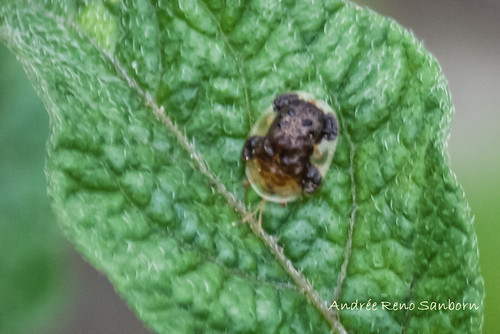clavate tortoise beetle
(Helocassis clavata)
Conservation • Description • Habitat • Ecology • Distribution • Taxonomy
Conservation Status |
|
|||||||
| IUCN Red List | not listed |
|||||||
| NatureServe | NNR - Unranked |
|||||||
| Minnesota | not listed |
|||||||
Description |
||
Clavate tortoise beetle is fairly common in North and Central America. In the United States it occurs from the northeast to the Great Plains. It is easily recognized by the wrinkled upper surface with a dark teddy bear-like pattern. Adults are tortoise-shaped, ¼″ to 5 ⁄16″ (6.5 to 7.5 mm) long, 3 ⁄16″ to ¼″ (5.5 to 6.3 mm) wide, oval when viewed from above, and convex when viewed from the side. The female is larger than the male. The upper thoracic plate (pronotum) and hardened wing covers (elytra) are green and translucent. The edges are spread out, flattened, and thin, and extend over the head and legs. The front (anterior) edge of the pronotum is broadly rounded. A large, opaque, dark brown spot covers most of the elytra and extends onto the pronotum. The spot resembles a teddy bear, with the the teddy bear’s “head” on the pronotum and the front and hind “legs” reaching the elytral margins. The plate between the wing bases (scutellum) is also dark brown. There is also at least some gold coloration adjacent to the edges of the brown spot. The upper surface of the elytra is very rough with wrinkles, rounded projections, and a prominent peak in the middle behind the scutellum. The head is completely concealed when viewed from above. The eyes are not notched. The antennae are long but less than half as long as the body. They are mostly pale but some of the terminal segments are black. Segment 3 is slightly longer than segment 2, and segment 8 is distinctly longer than wide. The antennae are extended when at rest. There is no groove on the underside of the prothorax for them to be tucked into. The plate on the face above the mouth (clypeus) is completely horizontal. The last part of each leg (tarsus), corresponding to the foot, has five segments. The fourth segment is very short and is concealed within the broadened tip of the third segment, making the tarsus appear to have only four segments. The last segment bears a pair of claws. The dilation at the base of each claw is angular. |
||
Size |
||
Total length: ¼″ to 5 ⁄16″ |
||
Similar Species |
||
Habitat |
||
|
||
Ecology |
||
Season |
||
|
||
Behavior |
||
Adults eat round holes in the leaves. The larvae carry dried fecal matter over their body, presumably as a form of camouflage. The fecal matter is attached to a forked appendage on the last abdominal segment, and is held suspended over the body. |
||
Life Cycle |
||
|
||
Larva Food |
||
|
||
Adult Food |
||
Groundcherry (Physalis spp.) and nightshade (Solanum spp.) |
||
Distribution |
||||
|
Sources |
|||
| 6/16/2022 | ||||
Occurrence |
||||
Fairly common |
||||
Taxonomy |
|||
Order |
Coleoptera (Beetles) | ||
Suborder |
Polyphaga (Water, Rove, Scarab, Long-horned, Leaf, and Snout Beetles) | ||
Infraorder |
Cucujiformia | ||
Superfamily |
Chrysomeloidea (leaf beetles and allies) | ||
Family |
Chrysomelidae (leaf beetles) | ||
Subfamily |
Cassidinae (tortoise and hispine beetles) | ||
Tribe |
Cassidini (tortoise beetles) | ||
Genus |
Helocassis | ||
In World Catalogue of the Cassidinae, published in 1999, Polish taxonomist Lech Borowie proposed transferring eight species from the genus Plagiometriona to the new genus Helocassis. The move was then and now remains controversial. Most North American sources reject the move. Two notable exceptions are Integrated Taxonomic Information System (ITIS) and iNaturalist. A discussion on BugGuide.net gives a detailed – even exhaustive – explanation of their reasoning for rejecting the move in 2005. However, by 2022, BugGuide had accepted the move. NatureServe continues to use the name Plagiometriona clavata for this species. |
|||
Subordinate Taxa |
|||
clavate tortoise beetle (Helocassis clavata clavata) clavate tortoise beetle (Helocassis clavata testudinaria) |
|||
Synonyms |
|||
Cassida clavata Coptocycla testudinaria Plagiometriona clavata |
|||
Common Names |
|||
clavate tortoise beetle translucent tortoise beetle |
|||
Glossary
Clypeus
On insects, a hardened plate on the face above the upper lip (labrum).
Elytra
The hardened or leathery forewings of beetles used to protect the fragile hindwings, which are used for flying. Singular: elytron.
Pronotum
The exoskeletal plate on the upper side of the first segment of the thorax of an insect.
Scutellum
The exoskeletal plate covering the rearward (posterior) part of the middle segment of the thorax in some insects. In Coleoptera, Hemiptera, and Homoptera, the dorsal, often triangular plate behind the pronotum and between the bases of the front wings. In Diptera, the exoskeletal plate between the abdomen and the thorax.
Tarsus
On insects, the last two to five subdivisions of the leg, attached to the tibia; the foot. On spiders, the last segment of the leg. Plural: tarsi.
Visitor Photos |
|||||
Share your photo of this insect. |
|||||
| This button not working for you? Simply email us at info@MinnesotaSeasons.com. Attach one or more photos and, if you like, a caption. |
|||||
Alfredo Colon |
|||||
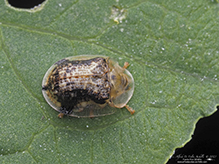 |
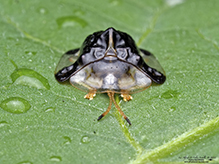 |
||||
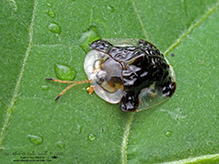 |
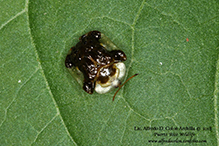 |
||||
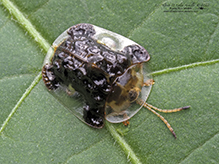 |
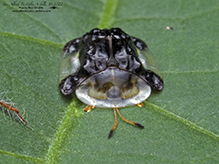 |
||||
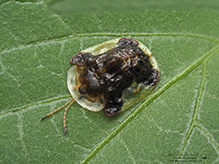 |
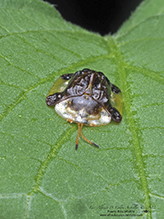 |
||||
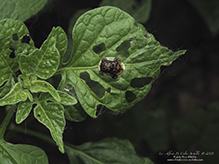 |
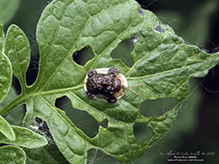 |
||||
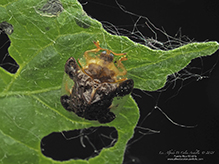 |
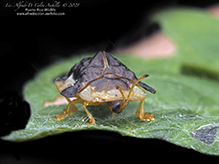 |
||||
Laurie Olesen |
|||||
Hello. I don't know if you are still keeping track of these little things. But I found one at Boot Lake SNA yesterday. Anoka County, MN. |
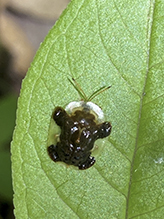 |
||||
Thomas Dilliplane |
|||||
Found outdoors in back yard. |
|||||
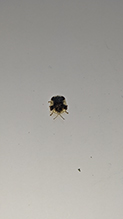 |
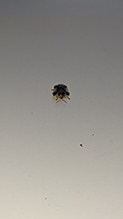 |
||||
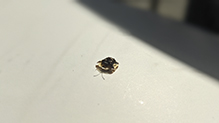 |
|||||
MinnesotaSeasons.com Photos |
|||||
|
|||||

Visitor Videos |
|||
Share your video of this insect. |
|||
| This button not working for you? Simply email us at info@MinnesotaSeasons.com. Attach a video, a YouTube link, or a cloud storage link. |
|||
Other Videos |
|||
| Tortoise Beetle seahue |
|||
About
Published on May 26, 2012 Behold my first Clavate Tortoise Beetle! I have seen this interesting insect in my insect book for decades and FINALLY get to see a real one. Of course, as with any unique looking insect, I only found ONE. |
|||


Created: 1/7/2019
Last Updated:

